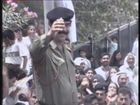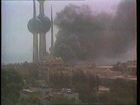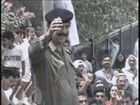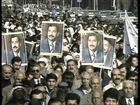Browse Person - 4941 results
Sort
3 carnivals and a half
directed by Michele Trentini, fl. 2015; produced by Museo degli usi e costumi della gente trentina (London, England: Royal Anthropological Institute, 2007), 51 mins
One day in Valfloriana, one day in Grauno in Val di Cembra, one day in Palù del Fersina in the Val dei Mòcheni) following three (and a half ...) of the most significant traditional carnivals that still take place in Trentino. Far from the now prevalent format of the parade of masked wagons, these carnivals actua...
Sample
directed by Michele Trentini, fl. 2015; produced by Museo degli usi e costumi della gente trentina (London, England: Royal Anthropological Institute, 2007), 51 mins
Description
One day in Valfloriana, one day in Grauno in Val di Cembra, one day in Palù del Fersina in the Val dei Mòcheni) following three (and a half ...) of the most significant traditional carnivals that still take place in Trentino. Far from the now prevalent format of the parade of masked wagons, these carnivals actually correspond to as many winter fertility rites as they are found in folklore throughout Europe.
Field of Study
Anthropology
Content Type
Documentary
Contributor
Giovanni Kezich, 1956-, Museo degli usi e costumi della gente trentina
Author / Creator
Michele Trentini, fl. 2015, Giovanni Kezich, 1956-
Date Published / Released
2007
Publisher
Royal Anthropological Institute
Copyright Message
Copyright © Royal Anthropological Institute
×
6 Battle for the Gulf, 1 of 6, A Summer Cloud
in 6 Battle for the Gulf, 1 of 6 (London, England: SW Pictures, 2001), 52 mins
At the end of the Iran-Iraq War, Iraq was close to bankruptcy because of President Saddam Hussein’s military spending and his attempts to build nuclear weapons. The U.S. had sided with Saddam Hussein during Iraq’s eight-year war with Iran, but the American government was confident it could contain his ambition...
Sample
in 6 Battle for the Gulf, 1 of 6 (London, England: SW Pictures, 2001), 52 mins
Description
At the end of the Iran-Iraq War, Iraq was close to bankruptcy because of President Saddam Hussein’s military spending and his attempts to build nuclear weapons. The U.S. had sided with Saddam Hussein during Iraq’s eight-year war with Iran, but the American government was confident it could contain his ambitions. As an oil-rich country, Saddam tried to re-fill his coffers by selling oil at the highest possible price, but he blamed the Emir of...
At the end of the Iran-Iraq War, Iraq was close to bankruptcy because of President Saddam Hussein’s military spending and his attempts to build nuclear weapons. The U.S. had sided with Saddam Hussein during Iraq’s eight-year war with Iran, but the American government was confident it could contain his ambitions. As an oil-rich country, Saddam tried to re-fill his coffers by selling oil at the highest possible price, but he blamed the Emir of Kuwait of flooding the market with cheap oil, lowering prices and hastening Iraq’s descent into economic crisis. The Iraqi foreign minister, Tariq Aziz, said Iraq started to realize that there was a conspiracy against them by Kuwait, organized and devised by the United States. Saddam issued the Emir of Kuwait with a stark warning – “each dollar less in the price of oil means to us one billion dollars in revenue for a year. If you do not mean to wage a war against Iraq, please stop it.” But the Emir refused and a month later, Saddam’s inner circle decided that unless Kuwait handed over $10 billion to Iraq immediately, they would invade. The way Iraq saw it, they had no choice but to act, either to be destroyed, to be suffocated and strangled inside its territory or attack the enemy on the outside. The Republican Guard was ordered to move south toward Iraq’s border with Kuwait. These were the Iraqi Army’s elite divisions, equipped with Soviet tanks. No other Middle Eastern country except Israel had forces to rival them. Soon 30,000 Iraqi troops had massed on the border between Iraq and Kuwait. With the crisis building, Egyptian President Hosni Mubarak rushed to Baghdad, sent by Kuwait and the Arab world to arrange negotiations. Mubarak, one of America’s closest allies in the region, was determined to discover Saddam’s plans. It was an encounter that would have far-reaching consequences. The day after Mubarak’s visit, Saddam abruptly summoned the American ambassador, April Glaspie, to sound her out as to what the American position would be if the Iraqis moved against the Kuwaitis. And the response that he got was a very satisfactory one. But the Iraqi threat was still building on the Kuwaiti border. The original 30,000 troops grew to 70,000 then 100,000. Arab leaders continued to insist it was all a bluff. Then, on August 1st, the Iraqis walked out on talks when the Kuwaitis refused to meet their demands. Saddam issued his orders to invade.
Show more
Show less
Field of Study
Global Issues
Content Type
Documentary
Contributor
Andrew Solomon, 1963-
Date Published / Released
2001
Publisher
SW Pictures
Series
6 Battle for the Gulf
Speaker / Narrator
Andrew Solomon, 1963-
Person Discussed
Nizar Hamdoun, 1944-2003, Tariq Aziz, 1936-2000, John Hubert Kelly, 1939-2011, Abdul Rahman Al-Awadi, Saad Al-Salim Al-Sabah, 1930-2008, Prince Bandar bin Sultan, 1949-, Brent Scowcroft, 1925-, Ali al-Khalifa al-Athbi Al-Sabah, fl. 1989, Richard N. Haass, 1951-, Saddam Hussein, 1937-2006, George H. W. Bush, 1924-2018, Bob Dole, 1923-, April Glaspie, 1942-
Topic / Theme
Iraq (1970s - Present), Economic conditions, Iran-Iraq War, 1980-1988, History, Diplomacy, Politics & Policy, Law, Kuwaitis, Iraqis, Russians, Arabs, Israelis, 20th Century in World History (1914--2000)
Copyright Message
Copyright © 2001 SW Pictures
×
6 Battle for the Gulf, 2 of 6, A Dark and Frightening Picture
in 6 Battle for the Gulf, 2 of 6 (London, England: SW Pictures, 2001), 50 mins
This film begins on August 2nd, 1990 – the day Iraq invaded Kuwait. Republican Guard tanks sealed off the city while Iraqi special-forces seized government buildings. The advancing Iraqis met little resistance. The Emir had stood down his army to avoid provoking Saddam. Many of his soldiers were taking their sum...
Sample
in 6 Battle for the Gulf, 2 of 6 (London, England: SW Pictures, 2001), 50 mins
Description
This film begins on August 2nd, 1990 – the day Iraq invaded Kuwait. Republican Guard tanks sealed off the city while Iraqi special-forces seized government buildings. The advancing Iraqis met little resistance. The Emir had stood down his army to avoid provoking Saddam. Many of his soldiers were taking their summer vacations. By noon, Saddam Hussein controlled one fifth of the world’s oil. The biggest question for the US was whether Saddam wo...
This film begins on August 2nd, 1990 – the day Iraq invaded Kuwait. Republican Guard tanks sealed off the city while Iraqi special-forces seized government buildings. The advancing Iraqis met little resistance. The Emir had stood down his army to avoid provoking Saddam. Many of his soldiers were taking their summer vacations. By noon, Saddam Hussein controlled one fifth of the world’s oil. The biggest question for the US was whether Saddam would stop at the borders of Kuwait or go into Saudi Arabia and move down to the oil fields? For Arab leaders, the biggest question was whether they could resolve the situation without involving outside forces. Satellite images showed two Iraqi divisions near the Saudi border. The US President, George Bush, dispatched his Defence Secretary Dick Cheney to Saudi Arabia. Cheney and his high-level delegation had to convince the Saudi rulers, who had never allowed U.S. troops on their soil, that they could soon become another Kuwait if they didn’t allow US forces to come to their aid. Cheney told King Fahd that he did not have the luxury of waiting until Saddam began an invasion of Saudi Arabia and then ask for US help, because then it would be too late. King Fahd agreed & soon more than 250,000 troops arrived in Saudi Arabia from the USA, Britain, France and Egypt – the beginnings of a coalition of 30 countries. Saddam Hussein had never expected to see forces from America, the great ally of Israel, operating from Arab soil. But the invasion had turned both western and Arab governments against Iraq. The US Secretary of State, James Baker and Bush had methodically built a broad international coalition to oppose Saddam. Ultimately, Bush would convince over 30 nations to contribute financial or military support to the effort.
Show more
Show less
Field of Study
Global Issues
Content Type
Documentary
Contributor
Andrew Solomon, 1963-
Date Published / Released
2001
Publisher
SW Pictures
Series
6 Battle for the Gulf
Speaker / Narrator
Andrew Solomon, 1963-
Person Discussed
Jean-Pierre Chevenement, 1939-, Fahd bin Abdulaziz Al Saud, 1921-2005, Moshe Arens, 1925-2019, Martin Stanton, fl. 1990, Jaber Al-Khalid, fl. 1990, Talal Abu Rahmah, fl. 1990, Saad Al-Salim Al-Sabah, 1930-2008, Dick Cheney, 1941-, George H. W. Bush, 1924-2018, Hosni Mubarak, 1928-, Norman Schwarzkopf, 1934-, James Addison Baker, 1930-, François Mitterrand, 1916-1996, Saddam Hussein, 1937-2006
Topic / Theme
Iraq (1970s - Present), Military occupation, Economic conditions, Iran-Iraq War, 1980-1988, History, Diplomacy, Politics & Policy, Law, Russians, Israelis, Arabs, Kuwaitis, Iraqis, 20th Century in World History (1914--2000)
Copyright Message
Copyright © 2001 SW Pictures
×
6 Battle for the Gulf, 3 of 6, Wrong on All Points
in 6 Battle for the Gulf, 3 of 6 (London, England: SW Pictures, 2001), 50 mins
Republican Guard tanks sealed off Kuwait city while Iraqi special forces seized government buildings. The advancing Iraqis met little resistance. The Emir had stood down his army to avoid provoking Saddam. Many of his soldiers were taking their summer vacations. Saddam thought any reprisals would be limited and wo...
Sample
in 6 Battle for the Gulf, 3 of 6 (London, England: SW Pictures, 2001), 50 mins
Description
Republican Guard tanks sealed off Kuwait city while Iraqi special forces seized government buildings. The advancing Iraqis met little resistance. The Emir had stood down his army to avoid provoking Saddam. Many of his soldiers were taking their summer vacations. Saddam thought any reprisals would be limited and would tail off with time. In the words of President Hafez Assad of Syria at a conference of Arab leaders at the time, “Kuwait has been...
Republican Guard tanks sealed off Kuwait city while Iraqi special forces seized government buildings. The advancing Iraqis met little resistance. The Emir had stood down his army to avoid provoking Saddam. Many of his soldiers were taking their summer vacations. Saddam thought any reprisals would be limited and would tail off with time. In the words of President Hafez Assad of Syria at a conference of Arab leaders at the time, “Kuwait has been occupied by Iraqi forces, who has the military might to expel them? Let him come forward and take command. Do not even mention foreign forces. Please come forward and tell us now”. There was silence by all Arab leaders. Saddam thought that America’s defeat in Vietnam had badly damaged its willingness to use military power. He also assumed that King Fahd would never allow US troops into Saudi Arabia and that the Soviet Union would never allow the use of force against Iraq as it was geographically very close to Iraq. He also thought that Kuwaitis were not internationally well liked and nobody would come to their aid. He was wrong on all these points. For Egyptian president Hosni Mubarak it was shocking. He couldn’t believe that this could happen in the Arab world. He regarded Saddam Hussein as a friend and didn’t expect him to invade. For the Americans getting the Soviet Union on board was imperative. US Secretary of State, James Baker, said that with Soviet support the US was able to marshal the international coalition that they were able to build up. He said it gave a completely different dynamic to the whole effort. Now, instead of being an effort by the United States and the United Kingdom to eject Iraq from Kuwait, it was an effort by the entire international community.
Show more
Show less
Field of Study
Global Issues
Content Type
Documentary
Contributor
Andrew Solomon, 1963-
Date Published / Released
2001
Publisher
SW Pictures
Series
6 Battle for the Gulf
Speaker / Narrator
Andrew Solomon, 1963-
Person Discussed
Mudar Badran, 1934-, Prince Bandar bin Sultan, 1949-, Saad Al-Salim Al-Sabah, 1930-2008, Fahd bin Abdulaziz Al Saud, 1921-2005, François Mitterrand, 1916-1996, Norman Schwarzkopf, 1934-, George H. W. Bush, 1924-2018, James Addison Baker, 1930-, Hosni Mubarak, 1928-, Saddam Hussein, 1937-2006, Yasser Arafat, 1929-2004
Topic / Theme
Iraq (1970s - Present), Military campaigns, Iran-Iraq War, 1980-1988, History, Diplomacy, Politics & Policy, Law, Americans, Kuwaitis, Arabs, Iraqis, Egyptians, Syrians, Jordanians, Palestinians, 20th Century in World History (1914--2000)
Copyright Message
Copyright © 2001 SW Pictures
×
6 Battle for the Gulf, 4 of 6, The 19th Province
in 6 Battle for the Gulf, 4 of 6 (London, England: SW Pictures, 2001), 51 mins
The Cairo conference, the diplomatic offensive, the exodus of refugees from Kuwait, the military mobilization and the Allied decision to go on the offensive on November 8th, 1990. The occupation of Kuwait, the organisation of the resistance, the military build-up of 700,000 troops and the final diplomatic rounds....
Sample
in 6 Battle for the Gulf, 4 of 6 (London, England: SW Pictures, 2001), 51 mins
Description
The Cairo conference, the diplomatic offensive, the exodus of refugees from Kuwait, the military mobilization and the Allied decision to go on the offensive on November 8th, 1990. The occupation of Kuwait, the organisation of the resistance, the military build-up of 700,000 troops and the final diplomatic rounds. The Geneva conference. The air war, the retaliatory Scud missile attacks on Israel and the ground offensive to the moment of Iraq’s s...
The Cairo conference, the diplomatic offensive, the exodus of refugees from Kuwait, the military mobilization and the Allied decision to go on the offensive on November 8th, 1990. The occupation of Kuwait, the organisation of the resistance, the military build-up of 700,000 troops and the final diplomatic rounds. The Geneva conference. The air war, the retaliatory Scud missile attacks on Israel and the ground offensive to the moment of Iraq’s surrender.
Show more
Show less
Field of Study
Global Issues
Content Type
Documentary
Contributor
Andrew Solomon, 1963-
Date Published / Released
2001
Publisher
SW Pictures
Series
6 Battle for the Gulf
Speaker / Narrator
Andrew Solomon, 1963-
Person Discussed
Saud Nasser Al-Saud Al-Sabah, 1944-2012, Ebraheem M. H. Behbahani, fl. 1990, Abdullah Al-Khandari, fl. 1990, Salem Al-Ali Al-Sabah, 1926-, Salem Al-Dayed, fl. 1990, Mahmoud Al-Doussari, fl. 1990, Saad Al-Salim Al-Sabah, 1930-2008, Barbara Bodine, 1948-, Salem Abdulaziz Al Sabah, fl. 1990, Tariq Aziz, 1936-2000, George H. W. Bush, 1924-2018, James Addison Baker, 1930-, Saddam Hussein, 1937-2006, No...
Saud Nasser Al-Saud Al-Sabah, 1944-2012, Ebraheem M. H. Behbahani, fl. 1990, Abdullah Al-Khandari, fl. 1990, Salem Al-Ali Al-Sabah, 1926-, Salem Al-Dayed, fl. 1990, Mahmoud Al-Doussari, fl. 1990, Saad Al-Salim Al-Sabah, 1930-2008, Barbara Bodine, 1948-, Salem Abdulaziz Al Sabah, fl. 1990, Tariq Aziz, 1936-2000, George H. W. Bush, 1924-2018, James Addison Baker, 1930-, Saddam Hussein, 1937-2006, Norman Schwarzkopf, 1934-, Sabah Al-Ahmad Al-Jaber Al-Sabah, 1929-
Show more
Show less
Topic / Theme
Iraq (1970s - Present), International sanctions, Diplomatic missions, Air raids, Iran-Iraq War, 1980-1988, History, Diplomacy, Politics & Policy, Law, British, Americans, Iraqis, Kuwaitis, 20th Century in World History (1914--2000)
Copyright Message
Copyright © 2001 SW Pictures
×
6 Battle for the Gulf, 5 of 6, A Different Kind of War
in 6 Battle for the Gulf, 5 of 6 (London, England: SW Pictures, 2001), 50 mins
The air war by the Allies begins. The Allies started jamming Baghdad’s radar defences. The jamming gave the game away. Iraqi radars were blinded, but 3,000 anti-aircraft guns and 60 missile batteries began firing wildly into the sky. Allied missiles destroyed the main telephone tower. Another laser-guided bomb h...
Sample
in 6 Battle for the Gulf, 5 of 6 (London, England: SW Pictures, 2001), 50 mins
Description
The air war by the Allies begins. The Allies started jamming Baghdad’s radar defences. The jamming gave the game away. Iraqi radars were blinded, but 3,000 anti-aircraft guns and 60 missile batteries began firing wildly into the sky. Allied missiles destroyed the main telephone tower. Another laser-guided bomb hit the headquarters controlling Baghdad’s air defences. Other pilots destroyed government ministries and a key communications tower....
The air war by the Allies begins. The Allies started jamming Baghdad’s radar defences. The jamming gave the game away. Iraqi radars were blinded, but 3,000 anti-aircraft guns and 60 missile batteries began firing wildly into the sky. Allied missiles destroyed the main telephone tower. Another laser-guided bomb hit the headquarters controlling Baghdad’s air defences. Other pilots destroyed government ministries and a key communications tower. With Baghdad’s air defence headquarters destroyed and its radar system in chaos, hundreds of Iraq’s fighters couldn’t operate. Only a few struggled into the air. With hundreds of allied aircraft flying, AWACS planes packed with computer equipment helped control the battle. On the first night the coalition armada systematically attacked Iraq’s war machine. The factories that made chemical and biological weapons, the Scud missile plants – in all over 200 different targets were hit. It was a new benchmark in the history of warfare, the first time the world had seen precision bombing on a vast scale. And defying all expectations, only one allied pilot, an American, had been killed. With air superiority established over the Iraqis, the coalition air planners were now confident enough to launch conventional aircraft on massive daylight raids. When Saddam met with his ministers after the first night’s bombing, he had already ordered action he believed would shatter the coalition of Western and Arab countries attacking Iraq. Scud missile launchers hidden in the desert fired at Israel. The Scuds were fired indiscriminately at Israel’s largest city. Saddam calculated the Israelis would retaliate and join the conflict. The Arabs in the coalition would then refuse to fight alongside Israel. The coalition would collapse and so would the war. Soon more Scuds were on the way. Israel’s nuclear forces now went on full alert. Sixty Israeli jets took to the skies. Early warning radar appeared to show Iraqi bombers headed for Israel. In the Pentagon, the defence secretary picked up the hotline to Tel Aviv. Israeli retaliation seemed inevitable. The Israeli Army reported nerve gas in the debris of one of the missiles. Israelis prepared for the worst. Ultimately, none of the eight Scuds that landed proved to have chemical warheads. After some discussion, Baghdad had decided the Israelis might retaliate against a chemical attack with nuclear weapons. The man who would decide what happened next was Prime Minister Yitzhak Shamir. He and George Bush disliked each other and when Bush telephoned him, Shamir angrily told the president that if America couldn’t stop the Scuds, the Israeli Air Force would. The Israeli Defence Minister, Moshe Arens, told us that Bush said to Shamir, pleaded with Shamir, tried to cajole Shamir that Israel not take any military action, that this would be injurious to the allied cause, that in the final analysis, that this would also be injurious to Israel’s cause. Shamir told us what he said to Bush – “It’s very difficult, Mr. President. It’s very difficult. I don’t know what the day of tomorrow will bring, but at this moment, we will act accordingly, accordingly with your concepts.” On February 21st, forty-eight hours before the ground attack was due, Iraq’s foreign minister, Tariq Aziz, arrived in Moscow. Saddam’s admission that he was willing to withdraw from Kuwait had led to some frantic Soviet diplomacy to save their old ally from defeat. Aziz went straight to the Kremlin. The Soviet president was waiting. Aziz told Gorbachev Saddam wouldn’t accept the U.N. resolutions that called for Iraq to recognize Kuwait’s independence and pay it compensation. But, he said, Iraq would withdraw from Kuwait. Gorbachev thought this was good enough. He called the White House. The president summoned his key advisors to discuss the Soviet offer. If Iraq withdrew, it would mean no bloody ground war, but Saddam would walk away unpunished, his war machine undefeated. At dawn the president called Gorbachev to tell him the deal was unacceptable. Bush’s carefully crafted international coalition was fragmenting. The French president, Francois Mitterrand, called to demand more time for diplomacy. As hundreds of oil wells blazed across Kuwait, the president issued a final ultimatum. Saddam ignored the warning. To obey, he believed, would have humiliated him in the eyes of the Arab world. Within a month of the air war, the ground war by the Allies began to force Iraqi troops out of Kuwait. It was a very short and comprehensive victory.
Show more
Show less
Field of Study
Global Issues
Content Type
Documentary
Contributor
Andrew Solomon, 1963-
Date Published / Released
2001
Publisher
SW Pictures
Series
6 Battle for the Gulf
Speaker / Narrator
Andrew Solomon, 1963-
Person Discussed
Tariq Aziz, 1936-2000, Anatoly S. Chernyaev, 1921-2017, James Taylor, fl. 1991, Khalid bin Sultan Al Saud, 0049-, Adi Al-Mutairi, fl. 1991, Martin Stanton, fl. 1990, Hadhim Ahmad al-Tai, 1942-, Moshe Arens, 1925-2019, Mudar Badran, 1934-, Charles A. Horner, 1936-, Neged Al-Bora'i, fl. 1991, Mustafa Hamarneh, 1953-, Mustafa Khalil, fl. 1991, Dick Cheney, 1941-, Prince Bandar bin Sultan, 1949-, Mahm...
Tariq Aziz, 1936-2000, Anatoly S. Chernyaev, 1921-2017, James Taylor, fl. 1991, Khalid bin Sultan Al Saud, 0049-, Adi Al-Mutairi, fl. 1991, Martin Stanton, fl. 1990, Hadhim Ahmad al-Tai, 1942-, Moshe Arens, 1925-2019, Mudar Badran, 1934-, Charles A. Horner, 1936-, Neged Al-Bora'i, fl. 1991, Mustafa Hamarneh, 1953-, Mustafa Khalil, fl. 1991, Dick Cheney, 1941-, Prince Bandar bin Sultan, 1949-, Mahmoud Hadary, fl. 1991, Mikhail Gorbachev, 1931-, Norman Schwarzkopf, 1934-, Bernard Shaw, 1940-, Walter Cronkite, 1916-2009, George H. W. Bush, 1924-2018, Saddam Hussein, 1937-2006
Show more
Show less
Topic / Theme
Iraq (1970s - Present), Escalation (Conflict), Military alliances, Air raids, Persian Gulf War, 1991, Political and Social Movements, War and Violence, History, Diplomacy, Politics & Policy, Law, Russians, Arabs, Israelis, Iraqis, Americans, 20th Century in World History (1914--2000)
Copyright Message
Copyright © 2001 SW Pictures
×
6 Battle for the Gulf, 6 of 6, Wounds in the Soul
in 6 Battle for the Gulf, 6 of 6 (London, England: SW Pictures, 2001), 50 mins
Surrender at Safwan: a secret deal? The rebellions by the Kurds in the north and Shia in the south; the imposition of sanctions on post-war Iraq. The effects of the war on Iraq, on Saudi Arabia and on Palestine.
Sample
in 6 Battle for the Gulf, 6 of 6 (London, England: SW Pictures, 2001), 50 mins
Description
Surrender at Safwan: a secret deal? The rebellions by the Kurds in the north and Shia in the south; the imposition of sanctions on post-war Iraq. The effects of the war on Iraq, on Saudi Arabia and on Palestine.
Date Written / Recorded
2001
Field of Study
Global Issues
Content Type
Documentary
Contributor
Andrew Solomon, 1963-
Date Published / Released
2001
Publisher
SW Pictures
Series
6 Battle for the Gulf
Speaker / Narrator
Andrew Solomon, 1963-
Person Discussed
Charles W. Freeman, 1943-, Haidar Abdel-Shafi, 1919-0207, Yitzhak Shamir, 1915-2012, Mikhail Gorbachev, 1931-, Rolf Ekeua, 1935-, Abdul Razak al-Hashimi, 1934-, James Addison Baker, 1930-, Mahmoud Osman, fl. 1991, Hussein Ali Al-Shaalan, fl. 1991, Tawfiq Al-Yassari, fl. 1991, Dick Cheney, 1941-, Victor Poussouvaluk, fl. 1991, Brent Scowcroft, 1925-, Prince Bandar bin Sultan, 1949-, Edward Gnehm, 1...
Charles W. Freeman, 1943-, Haidar Abdel-Shafi, 1919-0207, Yitzhak Shamir, 1915-2012, Mikhail Gorbachev, 1931-, Rolf Ekeua, 1935-, Abdul Razak al-Hashimi, 1934-, James Addison Baker, 1930-, Mahmoud Osman, fl. 1991, Hussein Ali Al-Shaalan, fl. 1991, Tawfiq Al-Yassari, fl. 1991, Dick Cheney, 1941-, Victor Poussouvaluk, fl. 1991, Brent Scowcroft, 1925-, Prince Bandar bin Sultan, 1949-, Edward Gnehm, 1944-, Saud Nasser Al-Saud Al-Sabah, 1944-2012, Najib Al-Salihi, fl. 1991, John J. Yeosock, 1937-1912, Richard N. Haass, 1951-, Khaled Al-Sultan, 1940-, Turgut Ozal, 1927-1993, George H. W. Bush, 1924-2018, Saddam Hussein, 1937-2006, Norman Schwarzkopf, 1934-
Show more
Show less
Topic / Theme
Iraq (1970s - Present), International sanctions, Military occupation, Persian Gulf War, 1991, Political and Social Movements, War and Violence, History, Diplomacy, Politics & Policy, Law, Turkish, Americans, Kurdish, Arabs, Iraqis, 20th Century in World History (1914--2000)
Copyright Message
Copyright © 2001 SW Pictures
×
10 Things You Need to Know About Losing Weight
directed by Chris Salt; presented by Michael Mosley, 1957-; produced by Chris Salt, British Broadcasting Corporation (London, England: BBC Worldwide, 2009), 1 hour 1 mins
It sometimes seems as though everyone is on, or about to start a diet. This entertaining, and informative program looks at the worldwide obsession with weight loss, exploring the ways and means by which people go about trying to lose weight; explaining the scientific evidence of what works, and more importantly sh...
Sample
directed by Chris Salt; presented by Michael Mosley, 1957-; produced by Chris Salt, British Broadcasting Corporation (London, England: BBC Worldwide, 2009), 1 hour 1 mins
Description
It sometimes seems as though everyone is on, or about to start a diet. This entertaining, and informative program looks at the worldwide obsession with weight loss, exploring the ways and means by which people go about trying to lose weight; explaining the scientific evidence of what works, and more importantly showing ways to keep it off.
Field of Study
Health Policy
Content Type
Documentary
Contributor
Chris Salt, British Broadcasting Corporation, Les Keen, fl. 1998
Author / Creator
Chris Salt, Michael Mosley, 1957-
Date Published / Released
2009
Publisher
BBC Worldwide
Speaker / Narrator
Les Keen, fl. 1998
Copyright Message
Copyright © 2009 BBC Worldwide
×
10 Things You Should Know About Sleep
directed by Richard Bright, fl. 2009 and Nick Mattingly, fl. 2009; presented by Kate Silverton, 1970-; produced by Richard Bright, fl. 2009 and Nick Mattingly, fl. 2009, British Broadcasting Corporation (London, England: BBC Worldwide, 2009), 1 hour 6 mins
Sleeping should be easy. You get tired, go to bed and wake up feeling refreshed and ready to face the day. But sometimes, regardless of how much you try, you just cannot keep your eyes closed. With revelatory stories of extreme sleeping problems along with genuine methods to help those desperate to get some shut-e...
Sample
directed by Richard Bright, fl. 2009 and Nick Mattingly, fl. 2009; presented by Kate Silverton, 1970-; produced by Richard Bright, fl. 2009 and Nick Mattingly, fl. 2009, British Broadcasting Corporation (London, England: BBC Worldwide, 2009), 1 hour 6 mins
Description
Sleeping should be easy. You get tired, go to bed and wake up feeling refreshed and ready to face the day. But sometimes, regardless of how much you try, you just cannot keep your eyes closed. With revelatory stories of extreme sleeping problems along with genuine methods to help those desperate to get some shut-eye, this programme offers ten top tips to trick your body into falling asleep more easily. Can food stop you from sleeping? How do solo...
Sleeping should be easy. You get tired, go to bed and wake up feeling refreshed and ready to face the day. But sometimes, regardless of how much you try, you just cannot keep your eyes closed. With revelatory stories of extreme sleeping problems along with genuine methods to help those desperate to get some shut-eye, this programme offers ten top tips to trick your body into falling asleep more easily. Can food stop you from sleeping? How do solo yachtsmen combat the lack of sleep? Does having a late night tipple help you get to sleep? These and many other questions are answered in this timely, informative and entertaining guide.
Show more
Show less
Field of Study
Counseling & Therapy
Content Type
Documentary
Contributor
Richard Bright, fl. 2009, Nick Mattingly, fl. 2009, British Broadcasting Corporation
Author / Creator
Richard Bright, fl. 2009, Nick Mattingly, fl. 2009, Kate Silverton, 1970-
Date Published / Released
2009
Publisher
BBC Worldwide
Topic / Theme
Disorders, Sleep disorders, Insomnia, Light therapy, Relaxation strategies
Copyright Message
Copyright © 2009 BBC Worldwide
×
20 Steps to Better Management, 7, Better Team Performance
produced by Robert Cooke, fl. 1990, in 20 Steps to Better Management, 7 (London, England: BBC Worldwide, 1996), 14 mins
With a combination of pertinent comment delivered by Hugh Dennis, plus real-life stories from case study companies and expert advice from leading consultant John Nicholson. The case studies are presented in a personal style that make it easy to transfer the learning points to the trainee's own workplace and experi...
Sample
produced by Robert Cooke, fl. 1990, in 20 Steps to Better Management, 7 (London, England: BBC Worldwide, 1996), 14 mins
Description
With a combination of pertinent comment delivered by Hugh Dennis, plus real-life stories from case study companies and expert advice from leading consultant John Nicholson. The case studies are presented in a personal style that make it easy to transfer the learning points to the trainee's own workplace and experience. This edition focuses on better team performance.
Field of Study
Business & Economics
Content Type
Documentary
Contributor
Robert Cooke, fl. 1990
Date Published / Released
1996
Publisher
BBC Worldwide
Series
20 Steps to Better Management
Speaker / Narrator
Hugh Dennis
Person Discussed
Hugh Dennis
Topic / Theme
Communication, Employee-management relations, Organizational effectiveness, Administration of Human Resource Programs, Management of Companies and Enterprises, Business & Economics
Copyright Message
Copyright © 2011 BBC Worldwide
×










